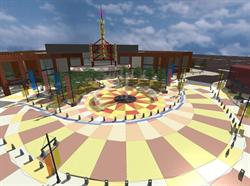
|
|
Megaplex Theatres Megaplex Theatres at The District (Megaplex 20 at the District) 11400 South Bangerter Highway South Jordan, Utah 84095 (801) 304-4020 megaplextheatres.com/thedistrict (2006) |
The Megaplex 20 at the District opened for business on 15 May 2006, with a Grand Opening ribbon-cutting ceremony on Friday, 19 May 2006. The Megaplex 20 is part of retail center named “The District”, located at 11400 South and Bangerter Highway. The District features several key anchor stores including Target, Harmons, Ross, Gart Sports, OfficeMax, JC Penny, and Best Buy. A “Main Street” lined with smaller shops leads to a spacious plaza and fountain, which serve as the gathering place for the development and entrance to the theater complex.
The lobby of the theater has an area equivalent to two basketball courts (10,200 square feet) and features a 244-seat Food Court. Besides the traditional popcorn stands, the Food Court offers eight different types of fast food to choose from, served in trays that can be taken into the auditoriums to enjoy a full meal while watching a movie. Two main concessions stands and two satellite stands along the corridors will serve soda and popcorn refills.
In the upper level of the lobby is a large conference room with a total capacity for 300 guests. The meeting room offers full catering service and can be subdivided into two or three smaller meeting rooms for family parties, corporate events, etc. Eight theater auditoriums offer the concept of Conference Mode that is available for private events.
Movie tickets can be purchased in the lobby from the six-register ticket counter or from 12 automatic ticket machines. The Megaplex 20 also features the first Drive-Thru ticket machine in Utah. Eight Internet access stations will be serve the food court area and two the events center on the upper level.
The theater complex has a main floor area of 144,500 square feet, equivalent to 2.5 NFL approved football fields. The twenty theater auditoriums have a combined capacity of 5,594 seats and are connected by two concourse-type corridors which cover 28,000 square feet and are over 350 yards long. The hallways range in width from 16' to 44.5' to comfortably allow circulation and queuing to all the theatres.
The two largest auditoriums, theaters 10 and 11, have 590 seats each, with 65-foot screens, and THX certification. All theaters offer digital sound and stadium seating with rows spaced 4'-0” apart. The seats use Memory Foam, a new technology which contours and adapts to the body shape to provide the maximum comfort.
Half of the theaters at the Megaplex 20 feature digital projection using Dolby Digital Cinema technology. Megaplex Theatres is confident enough in digital projection that they have dedicated seven auditoriums exclusively to digital movies. Three auditoriums have the capability of either digital or film projection.
“Our customers expect a truly unique experience when they visit a MEGAPLEX Theatre. We are proud of our place in history as the first to devote auditoriums exclusively to the digital cinema experience,” said Dale Harvey, General Manager of Megaplex Theatres.
Digital projectors use the same style of bulb as a film projector, but in place of the film is a series of mirrors which produce an array of 2048 by 1080 pixels in 35 trillion different colors. The image produced by digital projectors is designed to have the same look and feel as film, including the ability to provide excellent detail in the black areas of a movie. Missing from digital projection is the jittery motion that comes from moving film through a projector frame by frame.
“One of the beautiful things [with digital projection] is it's the same presentation today as you'll get six months from now,” explained Paul Pearson, a field service manager for Dolby Labs. “No scratches, no dirt, no imperfections. Every [35mm film] print that you see has something wrong with it – a scratch somewhere. It's a mechanical process as it's going through the printers, as it's being wound on reels, as it's being built up, as it's going in the projector. It's almost impossible not to get some little imperfection on it. Here you don't because it's all ones and zeros. It's all digital.”
Film prints of movies are shipped to the theater in several canisters and then manually spliced together, reel by reel, to form one huge product that fills the projector's platter. Digital movies arrive on a single hard disk drive and are then uploaded into the Dolby Show Store – a storage system that can hold up to ten hours of digital content and can even continue playback of a movie if one of its disk drives fails.
Digital movies are encrypted and cannot be played without a special key, which is sent by e-mail and then loaded into the Dolby Digital Cinema system using a USB memory stick. The key is a license which unlocks the movie for playback only for a period of time agreed upon by the distributer and exhibitor.
Movies are scheduled from a computer console using the Dolby Show Manager, user-friendly software that allows the projectionist to click and drag to select which previews show with the movie, when the house lights turn off and on, etc.
The digital projectors at the Megaplex 20 can be used for more than just movies. Between movies, they display on-screen video advertisements produced affiliate television station KJZZ 14. If an auditorium is rented for a corporate or business event, the digital projector can easily display Power Point presentations or other media.
